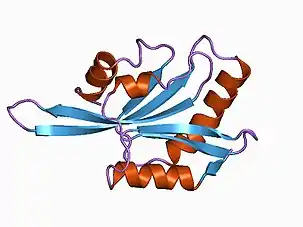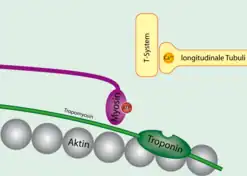ADF/Cofilin family
ADF/cofilin is a family of actin-binding proteins associated with the rapid depolymerization of actin microfilaments that give actin its characteristic dynamic instability.[1] This dynamic instability is central to actin's role in muscle contraction, cell motility and transcription regulation.[2]

Three highly conserved and highly (70%-82%) identical genes belonging to this family have been described in humans and mice:[3]
- CFL1, coding for cofilin 1 (non-muscle, or n-cofilin)
- CFL2, coding for cofilin 2 (found in muscle: m-cofilin)
- DSTN, coding for destrin, also known as ADF or actin depolymerizing factor
Actin-binding proteins regulate assembly and disassembly of actin filaments.[4] Cofilin, a member of the ADF/cofilin family is actually a protein with 70% sequence identity to destrin, making it part of the ADF/cofilin family of small ADP-binding proteins.[5][6] The protein binds to actin monomers and filaments, G actin and F actin, respectively.[7] Cofilin causes depolymerization at the minus end of filaments, thereby preventing their reassembly. The protein is known to sever actin filaments by creating more positive ends on filament fragments.[4] Cofilin/ADF (destrin) is likely to sever F-actin without capping [6] and prefers ADP-actin. These monomers can be recycled by profilin, activating monomers to go back into filament form again by an ADP-to-ATP exchange. ATP-actin is then available for assembly.[4]
Structure

The structure of actin depolymerizing factors is highly conserved across many organism due to actin's importance in many cellular processes.[8] Proteins of the actin depolymerizing factor family characteristically consist of five beta sheets, four antiparallel and one parallel, and four alpha helices with a central alpha helix providing the structure and stability of the proteins.[8] The actin depolymerizing factor homology domain (ADF-H domain) allows for binding to actin subunits and includes the central alpha helix, the N-terminus extension, and the C terminus helix.[9][8]
- The N-terminus extension consists of a tilted loop that facilitates binding to G-actin but not F-actin due to steric hindrance present in F-actin.[8]
- The C-terminus can form hydrogen bonds to F actin through its amide backbone and a serine at position S274. This serine is especially highly evolutionarily conserved due to its importance in actin binding.[8]
- The central alpha helix is inserted into the hydrophobic cleft in between the first and third subunits of actin during actin binding.[8]
Cofilin binds monomeric (G-actin) and filamentous actin (F-actin). Its binding affinities are higher for ADP-actin over ADP-Pi and ATP-actin. Its binding changes the twist of F-actin. The structure of ADF was first characterized in 1980 by James Bamburg.[10] Four actin histidines near the cofilin binding site may be needed for cofilin/actin interaction, but pH sensitivity alone may not be enough of an explanation for the levels of interaction encountered. Cofilin is accommodated in ADP-F actin because of increased flexibility in this form of actin. Binding by both cofilin and ADF (destrin) causes the crossover length of the filament to be reduced. Therefore, strains increase filament dynamics and the level of filament fragmentation observed.[6]
Function
Cofilin is a ubiquitous actin-binding factor required for the reorganization of actin filaments. ADF/Cofilin family members bind G-actin monomers and depolymerize actin filaments through two mechanisms: severing[11] and increasing the off-rate for actin monomers from the pointed end.[12] "Older" ADP/ADP-Pi actin filaments free of tropomyosin and proper pH are required for cofilin to function effectively. In the presence of readily available ATP-G-actin cofilin speeds up actin polymerization via its actin-severing activity (providing free barbed ends for further polymerization and nucleation by the Arp2/3 complex).[13] As a long-lasting in vivo effect, cofilin recycles older ADP-F-actin, helping cell to maintain ATP-G-actin pool for sustained motility. pH, phosphorylation and phosphoinositides regulate cofilin's binding and associating activity with actin[7]
The Arp2/3 complex and cofilin work together to reorganize the actin filaments in the cytoskeleton. Arp 2/3, an actin binding proteins complex, binds to the side of ATP-F-actin near the growing barbed end of the filament, causing nucleation of a new F-actin branch,[13] while cofilin-driven depolymerization takes place after dissociating from the Arp2/3 complex.[4] They also work together to reorganize actin filaments in order to traffic more proteins by vesicle to continue the growth of filaments.[14]
Cofilin also binds with other proteins such as myosin, tropomyosin, α-actinin, gelsolin and scruin. These proteins compete with cofilin for actin binding.[6] Сofilin also play role in innate immune response.
In a Model Organism
ADF/cofilin is found in ruffling membranes and at the leading edge of mobile cells.[12] In particular, ADF/cofilin promotes disassembly of the filament at the rear of the brush in Xenopus laevis lamellipodia, a protrusion from fibroblast cells characterized by actin networks. Subunits are added to barbed ends and lost from rear-facing pointed ends. Increasing the rate constant, k, for actin dissociation from the pointed ends was found to sever actin filaments. Through this experimentation, it was found that ATP or ADP-Pi are probably involved in binding to actin filaments.[14]
Mechanism of Action
F-actin (filamentous actin) is stabilized when it is bound to ATP due to the presence of a serine on the second subunit of actin that is able to form hydrogen bonds to the last phosphate group in ATP and a nearby histidine attached to the main loop. This interaction stabilizes the structure internally due to the interactions between the main loop and the second subunit. When ATP is hydrolyzed to ADP, the serine can no longer form a hydrogen bond to ADP due to the loss of the inorganic phosphate which causes the serine side chain to twist, causing a conformational change in the second subunit.[15][12] This conformational change also causes the serine to no longer be able to form a hydrogen bond with the histidine attached to the main loop and this weakens the linkage between subunits one and three, causing the entire molecule to twist. This twisting puts strain on the molecule and destabilizes it.[2]
Actin depolymerizing factor is able to bind to the destabilized F-actin by inserting the central helix into the cleft between the first and third subunits of actin. Actin depolymerizing factor binds F-actin cooperatively and induces a conformational change in F-actin that causes it to twist further and become more destabilized. This twisting causes severing of the bond between actin monomers, depolymerizing the filament.[2]
Regulation
Phosphorylation
Actin depolymerization factor is regulated by the phosphorylation of a serine on the C terminus by LIM kinases.[16] Actin depolymerizing factor is activated when it is dephosphorylated and inhibited when it is phosphorylated.[17]
pH

An alkaline environment stabilizes the inorganic phosphate released when ATP is hydrolyzed to ADP, so therefore a higher pH increases the favorability of the ATP bound to F-actin to be hydrolyzed to ADP resulting in the destabilization of actin.[18]
Tropomyosin binding
F-actin binds the protein Tropomyosin and actin depolymerizing factor competitively and mutually exclusively. F-actin binding of Tropomyosin is uncooperative so therefore the binding of Tropomyosin does not induce a conformational change in F-actin and does not cause it to become destabilized.[17] However, because F-actin cannot bind both Tropomyosin and actin depolymerizing factor at the same time due to Tropomyosin blocking the binding site of actin depolymerizing factor when it is bound to actin, Tropomyosin acts as a protector of actin against depolymerization.[19]
References
- Actin+Depolymerizing+Factors at the U.S. National Library of Medicine Medical Subject Headings (MeSH)
- Dominguez R, Holmes KC (2011). "Actin structure and function". Annual Review of Biophysics. 40: 169–86. doi:10.1146/annurev-biophys-042910-155359. PMC 3130349. PMID 21314430.
- Menon S, Gupton SL (2016-01-01). "Building Blocks of Functioning Brain: Cytoskeletal Dynamics in Neuronal Development". International Review of Cell and Molecular Biology. 322: 183–245. doi:10.1016/bs.ircmb.2015.10.002. ISBN 9780128048092. PMC 4809367. PMID 26940519.
- Cooper, G. M. and R. E. Hausman. The Cell: A Molecular Approach, 3rd ed. Washington DC: ASM Press 2004 pp.436-440.
- Gunning PW, Ghoshdastider U, Whitaker S, Popp D, Robinson RC (2015). "The evolution of compositionally and functionally distinct actin filaments". Journal of Cell Science. 128 (11): 2009–19. doi:10.1242/jcs.165563. PMID 25788699.
- McGough A, Pope B, Chiu W, Weeds A (August 1997). "Cofilin changes the twist of F-actin: implications for actin filament dynamics and cellular function". J. Cell Biol. 138 (4): 771–81. doi:10.1083/jcb.138.4.771. PMC 2138052. PMID 9265645.
- Lappalainen P, Drubin DG (July 1997). "Cofilin promotes rapid actin filament turnover in vivo". Nature. 388 (6637): 78–82. Bibcode:1997Natur.388R..78L. doi:10.1038/40418. PMID 9214506. S2CID 205027806.
- Inada N (March 2017). "Plant actin depolymerizing factor: actin microfilament disassembly and more". Journal of Plant Research. 130 (2): 227–238. doi:10.1007/s10265-016-0899-8. PMC 5897475. PMID 28044231.
- Paavilainen VO, Oksanen E, Goldman A, Lappalainen P (July 2008). "Structure of the actin-depolymerizing factor homology domain in complex with actin". The Journal of Cell Biology. 182 (1): 51–9. doi:10.1083/jcb.200803100. PMC 2447895. PMID 18625842.
- Bamburg, JR; Harris, HE; Weeds, AG (17 November 1980). "Partial purification and characterization of an actin depolymerizing factor from brain". FEBS Lett. 121 (1): 178–82. doi:10.1016/0014-5793(80)81292-0. PMID 6893966. S2CID 42641895.
- Ichetovkin I, Han J, Pang KM, Knecht DA, Condeelis JS (April 2000). "Actin filaments are severed by both native and recombinant dictyostelium cofilin but to different extents". Cell Motil. Cytoskeleton. 45 (4): 293–306. doi:10.1002/(SICI)1097-0169(200004)45:4<293::AID-CM5>3.0.CO;2-1. PMID 10744862.
- Carlier MF, Laurent V, Santolini J, et al. (March 1997). "Actin depolymerizing factor (ADF/cofilin) enhances the rate of filament turnover: implication in actin-based motility". J. Cell Biol. 136 (6): 1307–22. doi:10.1083/jcb.136.6.1307. PMC 2132522. PMID 9087445.
- Ichetovkin I, Grant W, Condeelis J (January 2002). "Cofilin produces newly polymerized actin filaments that are preferred for dendritic nucleation by the Arp2/3 complex". Curr. Biol. 12 (1): 79–84. doi:10.1016/s0960-9822(01)00629-7. PMID 11790308. S2CID 15747359.
- Svitkina TM, Borisy GG (May 1999). "Arp2/3 complex and actin depolymerizing factor/cofilin in dendritic organization and treadmilling of actin filament array in lamellipodia". J. Cell Biol. 145 (5): 1009–26. doi:10.1083/jcb.145.5.1009. PMC 2133125. PMID 10352018.
- "How do actin filaments depolymerize?". MBInfo. Retrieved 2018-06-16.
- Prunier C, Prudent R, Kapur R, Sadoul K, Lafanechère L (June 2017). "LIM kinases: cofilin and beyond". Oncotarget. 8 (25): 41749–41763. doi:10.18632/oncotarget.16978. PMC 5522193. PMID 28445157.
- Bamburg JR, McGough A, Ono S (September 1999). "Putting a new twist on actin: ADF/cofilins modulate actin dynamics". Trends in Cell Biology. 9 (9): 364–70. doi:10.1016/S0962-8924(99)01619-0. PMID 10461190.
- Pope BJ, Zierler-Gould KM, Kühne R, Weeds AG, Ball LJ (February 2004). "Solution structure of human cofilin: actin binding, pH sensitivity, and relationship to actin-depolymerizing factor". The Journal of Biological Chemistry. 279 (6): 4840–8. doi:10.1074/jbc.M310148200. PMID 14627701.
- Bernstein BW, Bamburg JR (1982). "Tropomyosin binding to F-actin protects the F-actin from disassembly by brain actin-depolymerizing factor (ADF)". Cell Motility. 2 (1): 1–8. doi:10.1002/cm.970020102. PMID 6890875.